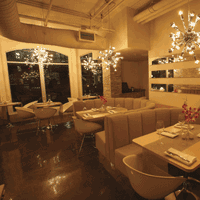Foodservice operators up their game, designing digs to appeal to discerning diners
Creating a new design concept can be as perilous as it is exciting. But when working from a blank canvas, the right creative designers can do wonders with any budget. Whether sourcing inexpensive materials to mimic stone, jazzing up a room with playful accoutrements, adding mirrors to create the illusion of space or incorporating a signature design piece — meat coolers and 40-foot televisions, anyone? — the magic is found in creating a sense of place and community.
Today, it’s about doing more for less, explains Melissa Cummings, partner, Design360 in Halifax. “Restaurants like to make the most of tight spaces. They’re also gravitating towards design concepts that create a personal connection,” she says, adding restaurateurs are opting for more natural tones and textures such as stone, metal and granite to reflect their local environs. “It’s not so frou-frou anymore.”
To wit, few would call Cut Steakhouse and Urban Grill in Halifax frou-frou. In fact, Cummings provided the design inspiration behind its dual concept. Located in a single waterfront piece of real estate in downtown Halifax, both restaurants were created to meet the needs of two completely different types of patrons.
The double billing made sense, says Shannon Bruhm, vice-president of the Halifaxbased RCR Hospitality Group. “We loved the building. But we didn’t think Halifax was ready for a high-end 150-seat dining room serving steak, so we opened two distinctly different restaurants instead.”
The upscale and intimate 70-seat Cut Steakhouse upstairs feeds an entirely different crowd than its sister space downstairs, the more casual Urban Grill, which accommodates up to 85 guests. An open kitchen on the main floor and prep kitchen on the lower floor service both restaurants, creating space for Cut to showcase its splendour — a layout that Cummings admits can present a few logistical challenges from a service standpoint.
That said, one of the biggest roadblocks was fitting the company’s design aspirations into its $1-million budget. “It’s difficult to do the things you really want to do and not lose your shirt,” says Bruhm. “You have to work within the boundaries of what you’re capable of doing while coming up with something unique enough to [entice] people to come — whether it’s for an upscale and intimate romantic dinner or a casual drop-in.”
The diner looking for a fine-dining experience will visit Cut Steakhouse, a study in stately opulence, with mirrored ceilings creating the illusion of height, rich black and silver accents and chain-mail screens suspended from the ceiling. The textured look is enhanced by richly upholstered chairs, quartz stone walls, dark hardwood floors, animal print carpeting and an Italian granite bar that brings a slight shimmer to the overall vibe.
On the main level, Urban Grill creates a casual-dining experience with its hustle, bustle and energy. “The Grill is a lot more open with higher ceilings and very large arched windows,” Bruhm says. “There we went for a funky, retro, urban look, that was contemporary, open and clean.” The exposed ceiling was painted white to increase the sense of airiness, he explains. The look is further enhanced by sleek polished concrete floors, stainless-steel accents and booths with light coloured suede upholstered seats, mirrored fronts and chrome bases. Retro-style moulded chairs and light wood tables complete the picture. The finishing touch and signature design element is the glassfronted, humidity-controlled walk-in cooler used to dry-age meat, estimated to have cost between $8,000 and $9,000. “We do our own butchery,” Bruhm explains. “That’s why we put the cooler right beside the open kitchen so guests can see the meat hanging there. Meat is what we’re about.”
Building outside the proverbial design box is one thing, but breaking out of the traditional mould of an established brand can require a different design sensibility altogether. For A&W Canada, launching the new A&W Urban street-front restaurants in August 2010 was one of the first major efforts to establish a new restaurant concept without compromising its iconic 1950s brand imperatives.
“Baby boomers have always been a primary target for A&W,” explains Rob Fussey, director of the Urban Concept, which is now open in Vancouver, Calgary and Toronto. “But we wanted to expand our reach to younger consumers in high- density population areas. What we developed, however, still had to feel like an A&W and keep our heritage imagery.”
After much research and discussion with 25 design firms throughout North America, a formula that would serve both worlds was pinpointed. The A&W Urban Design created by Frch Design Worldwide in Cincinnati, maintains the traditional orange, white and brown colour scheme, while showcasing familiar A&W logos and local imagery on walls, behind counters and on tabletops. “It took us six months to find the right firm that could interpret and understand brands in urban settings,” Fussey says. “Frch demonstrated an ability to do that on a worldwide scale.”
And, when it comes to scale of property, each location ranges from 1,400 to 2,000 sq. ft. with capital costs ringing in at approximately $600,000 to $800,000 on average. What stands out is the pseudoindustrial look and feel, where walls, counters and seating combine the visual elements of concrete, metal and stone. Even the wallpaper is a ringer for real cinder block. Seating is comprised of an eclectic mix of booths, individual tables and chairs and high counters for larger groups — a freezer full of frosted mugs is prominently displayed as a reminder of the brand’s roots. “Every detail is tied to reinforcing the brand, while achieving a cool, modern look. Even the music is different,” Fussey says.
Beyond the heritage elements, the entire layout is focused on a great service experience. The service counter is positioned diagonally to maximize space, while the backlit menus are prominently situated on the counter next to the point-of-sale system so customers can easily see what to order.
Another innovation at every A&W Urban eatery is the self-service kiosks where customers place and pay for their order, which they later collect at a dedicated pick-up area. So far, the innovation has proved successful. “Self-service can be a big logistical challenge,” Fussey admits. “You have to make sure you have the back-end processes in place to support it, including a separate spot to pick up the order.”
Finding support has never been problematic for Maple Leaf Sports and Entertainment (MLSE), which is used to selling out its sporting events. But when it came to creating its own bar and restaurant, building a brand was a fromthe- ground-up proposition.
Open less than a year, the newly constructed Real Sports Bar & Grill, in Toronto, has already been named the best sports bar in North America by ESPN. The design inspiration of the New York-based Rockwell Group, and the $11.75-million budget, allowed for a chance to reinvent the sports bar concept, says Michael Doyle, vice-president of Food and beverage for MLSE.
“Before we started all this, we visited sports bars throughout North America and discovered most have TVs thrown up on the wall and tables and chairs. We wanted to create something more organic that would appeal to sports fans, business people and women.”
The 26,300-sq.-ft., 40-foot-high interior is a show stopper. With 199 TVs recessed into just about every wall, nook and cranny and a 39-foot, $350,000 panel that dominates both levels of the cavernous space, the setup can stream content from almost 1,000 live audio and video events.
Restaurant “zones” showcase unique, understated design elements. The glossy surfaces of the basketball area’s high tables, for example, are made from hardwood reclaimed from the Air Canada Centre’s (ACC) basketball court, while a basket-weave sculpture dominates the back wall of the bar.
In the arena zone, designed to reflect the ACC itself, a 90-foot glass-top bar is a visual reminder of the ice in a hockey rink; while an overhead sports ticker gives a running tally of the latest scores and stats.
The soccer-themed mezzanine area’s moveable walls divide spaces for private group events. The players/VIP lounge is the centerpiece replete with comfy leather sofas and a cosy fireplace, all surrounded by a low wall. “It was designed so that teams could come in after a game and be seen, but still get some privacy,” Doyle explains.
A striking feature of the space is the absence of typical sports bar memorabilia. “You won’t find a sports helmet or jock strap displayed anywhere,” Doyle jokes. Instead, MLSE has opted for subtle reminders such as sculptures that reflect iconic trophies in the sporting world, custom-designed hockey-stick chandeliers and soccer-ball type stitching on leather seats as well as the upstairs bar area. LED lighting throughout the restaurant changes to reflect whatever sports team is playing.
The upscale “non-jock,” high-tech vibe is a deliberate move to create a milieu that would be equally attractive to women who account for 50 per cent of the clientele as sporting fans, concert goers and business professionals.
Even the culinary team, who work in the city’s largest kitchen, is in on the act, using golf tees to adorn club sandwiches and small baseball bats that are pepper mills in disguise. “We thought about an open kitchen, but realized it would interfere with sight lines to the screens,” Doyle explains.
In the end, regardless of the budget, the opportunity to create a new brand experience is invigorating. With the right creative talent, combined with a keen sense of the audience’s needs and unique signature accents, a restaurant’s decor should serve as the backdrop to a winning recipe for success.





















